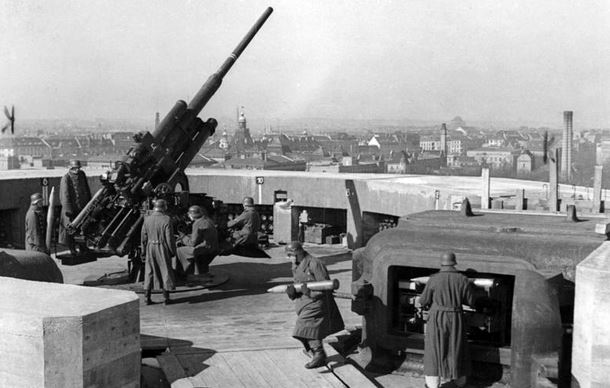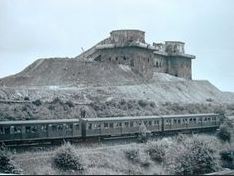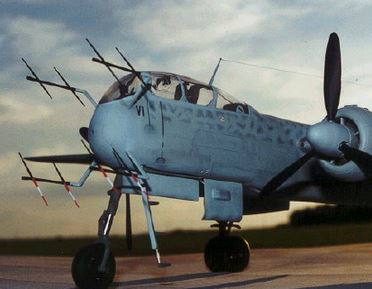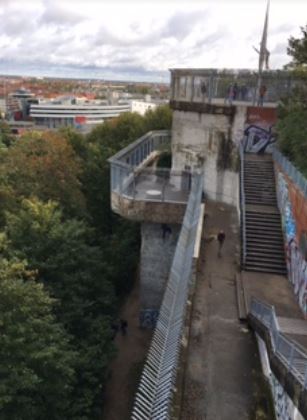 Somewhere I’d read that Berlin still had a giant flak tower left over from the war. We only had a week in an Airbnb flat in an outer suburb and I didn’t give the tower any priority. But our last day, a Sunday, was a slack morning. I checked and discovered the flak tower was only three stops down the U-Bahn in the Humboldthain Park.
Somewhere I’d read that Berlin still had a giant flak tower left over from the war. We only had a week in an Airbnb flat in an outer suburb and I didn’t give the tower any priority. But our last day, a Sunday, was a slack morning. I checked and discovered the flak tower was only three stops down the U-Bahn in the Humboldthain Park.
First, I’ll describe my morning’s adventure, and then how the Berlin flak towers defended the city. Detouring from my supermarket-shopping for lunch ingredients, I was at the park by 10.30 am. A path led to steps on a steep hill, with trees on all sides blocking the view. I couldn’t see any tower but kept climbing. In fact I was ascending a mountain of rubble around the 40m tower, which had been partly blown up by the French-zone occupiers in 1948.[1] They had to leave the north side intact because a Russian-run railway was only metres away in a deep cutting. For the same reason, the rubble mountain had to stop half-way up the tower to avoid avalanches into the cutting.
Once my view cleared, I could see the tower poking out of the hill like a giant concrete chimney. Its height is equal to a 13-storey building. From the roof, Berlin stretches to the horizon all around. To add to the visual drama, a roped-up mountaineer was half up the concrete face, urged on by companions just visible at the top.
The wall is pockmarked by Russian artillery hits during the battle for Berlin, but even the Russians’ 203mm cannon couldn’t weaken the 2-3m thick walls. On the roof I little knew I was walking on nearly four metres of reinforced concrete. At the roof’s highest point a blue and white vertical sculpture rises another 11m, with ravens jostling to sit on the top point. The sculpture is a 1967 monument towards a united Germany, sited for East Berliners to look up to, and to annoy their authorities.
At the roof’s two north corners are circular balconies that once surrounded 12.8cm anti-aircraft (AA) guns, four times more powerful than the standard 88mm AA guns. Below the gun pits was another platform which once bristled with 20mm quad cannons to fend off any lower-flying attackers. The roof and walkways were daubed with graffiti and confined by spiked black fences. Leftover trash from junkies didn’t improve the aesthetics.
I was just heading downstairs for home when I saw that a steel door in the central column was open, and a bearded young bloke was fussing inside with some paperwork. “Can I come in?” I asked in my best German, but he turned out to be a Sydneysider working for the Berlin Underworlds Association, which runs tower tours. “When’s the next one? Can I join?” I asked, without real hope.
“In five minutes, but it’s fully booked. The insurers are strict about numbers.”
He phoned his office anyway, grinned and said there had been two drop-outs. But after the tour I’d have to go back to his nearby office to pay the 11 Euro fee. The 90-minute tour also happened to be the only English-language tour that day. My luck was in! Our young Brazilian guide, Luiz, arrived with a group of about 25 in tow. The inside tour was not for sissies, and as we put on hard hats Luiz warned about trip-hazards, stepways, dark corners and group indiscipline. We were to traverse the upper three of the original six floors. No photos, please.
The whole interior was a gloomy jumble of concrete ruins and wall segments, created by demolition attempts involving fearsome tonnages of TNT. The initial blasts were meant to knock down the walls but the TNT just played havoc with the interior. I’ve seen nothing like this scale of destruction before. The only comparison would be with piles of big boulders flung onto shore by a tidal wave, or earthquake devastation. Luiz shone his torch at one ceiling where an internal reinforced-concrete wall had been anchored. This thick wall had been blown backwards about a metre.
Steel walkways join gaps in wrecked stairways. On all sides are black abysses. Decades ago, when the tower was not properly secured, young explorers got in and several were injured by falls, one fatally. Apart from concrete lumps, there were only some cabling trays on ceilings and meagre remnants of an elevator and an ammunition hoist. Looters, official and private, stripped everything bare, starting from the moment Berlin surrendered. One no-go area was a cavern inhabited by a dozen species of bats. To help them hibernate, the tours run only from April to October. Tour guides normally choose entertainment over accuracy, but Luiz kept us enthralled and didn’t make stuff up.
 The flak tower story is not well known, except to WW2 buffs. Records are patchy and the Russians still have secrets to keep, especially about art treasures they looted from safe storage in the towers. The first flak tower was at the Berlin Zoo (left), followed by another at Friedrichshain Park and finally “my” tower at Humboldthain. The coordinated trio was intended to put an anti-aircraft umbrella over central Berlin.
The flak tower story is not well known, except to WW2 buffs. Records are patchy and the Russians still have secrets to keep, especially about art treasures they looted from safe storage in the towers. The first flak tower was at the Berlin Zoo (left), followed by another at Friedrichshain Park and finally “my” tower at Humboldthain. The coordinated trio was intended to put an anti-aircraft umbrella over central Berlin.
In his Great Dictator spoof of 1940, Charlie Chaplin pulls the lanyard on a giant howitzer, which lobs a shell that demolishes a distant backyard dunny. The sequence that gave Hitler his tower idea was also somewhat farcical. The real-war timeline went:
Night of August 24-25, 1940: A JU88 bomber in a group targeting the Thameshaven Oil Terminal strays off-course and one of its bombs damages the Church of St Giles in Cripplegate in the East End.[2]
Night of 25-26 August: On Churchill’s orders for reprisal, a force of Hampdens and Wellingtons (all twin-engined), set off to bomb Berlin’s Tempelhof airport and a nearby Siemens factory complex. The Hampden raid merely destroyed the summerhouse of a home in Rosenthal suburb, injuring two people. The Wellingtons couldn’t find the factory under cloud, and their bombs fell on farmland, causing Berliners to joke that the Brits were trying to starve them out.
Night of August 28-29: Churchill orders a further Hampden raid, which hits housing around Berlin’s Goerlitzer railway station, killing eight, wounding 21 and causing vast German public indignation. The raids infuriated Hitler and Goering, the latter having invited Germans in September, 1939, to “call me ‘Meyer’” if any bomber got through to the Ruhr, which is 400km closer than Berlin for RAF pilots.[3]
Early September 1940: Hitler issues two directives. A public one orders revenge attacks on British cities, just as the Luftwaffe assault on RAF airfields is succeeding. The diversion, as everyone knows and writes, leads to Germany’s defeat in the Battle of Britain. Non-publicly, Hitler also orders construction of the flak towers, with secondary use as civilian air-raid shelters.[4] He even did some hand-sketches for the design.
In a bizarre touch, Hitler was so certain about Berlin’s immunity from ground attack that he integrated the towers into the design of his madman’s world-capital “Germania”.[5] The best 3D model of this “world capital” was built for the much-parodied Hitler bio-epic Downfall (2004). It has triumphal arcs (dwarfing the Arc de Triomphe) astride 120m-wide boulevards, and a People’s Hall 320m high for an audience of 180,000.[6] Hence the flak tower walls even had numerous openings for windows, ready for the imagined post-war museums, theatres and restaurants.
Building the towers was a serious diversion from Hitler’s primary war effort. Each day trains and barges needed to deliver 2000 tonnes of concrete, steel and timber. Germany’s national rail timetable was adjusted to give the  materials priority. The first tower was at the Zoo, with concrete pours round the clock to finish the job in six months. The site was flood-lit nightly despite the blackout, except during actual raids. As soon as this tower was completed, contractors started on the Friedrichshain Tower and finally Humboldthain (left). Hamburg later got two towers and Vienna three.[7] None were put out of action in the war.
materials priority. The first tower was at the Zoo, with concrete pours round the clock to finish the job in six months. The site was flood-lit nightly despite the blackout, except during actual raids. As soon as this tower was completed, contractors started on the Friedrichshain Tower and finally Humboldthain (left). Hamburg later got two towers and Vienna three.[7] None were put out of action in the war.
The Berlin towers at each top corner deployed a formidable 12.8cm AA gun. This had twin barrels 8m long, able to throw 26kg shells 15 kilometres high. Electrically loaded, each gun could fire up to 20 rounds a minute (80 per minute per tower). The gun’s 26-tonne weight made it impracticable except for the towers, and only 34 were in use by early 1945. Ammunition came up to the roof via a ‘paternoster’ lift (resembling an vertical escalator). This device was capped by a 72-tonne steel dome for protection against bombs. As a fail-safe, shells could be brought up four floors by a normal lift and hand-carried up two more floors.
Air Marshall Goering liked to visit the guns. He was prone to idly pushing buttons and testing levers, so before he arrived troops had to unload the live shells manually and substitute blanks. I found the spiral staircase taxing even without carrying shells – no wonder the troops hated Goering’s visits.
The smoke and shock waves meant the guns’ aiming data had to be generated off-site. Hence each tower had a more compact control tower within half a kilometre, connected by underground cables . That tower was similar in height (40m) but with sides only 50-by-23 metres, compared with 70-by-70m for the mighty gun towers.
The control tower system coordinated the total Berlin air defences, including observers, radar, searchlights, fighter planes, and guns. With its 6.5m diameter “Wuerzburg Giant” radar dishes, a control tower could pick up a bomber stream 70km out, and retract 12m down into an armored dome when bombs started to fall. The three towers’ gunners, with their massive firepower, sought to intercept bombers in a 250m-by-250m “shooting box” of bursting shells. The aiming had to “lead” the bombers by more than a kilometre ahead to allow for the shells’ 15 second travel. Planes could dive or weave but German analogue computers in the control towers could adjust the guns’ aim within 10-15 seconds.
 The third floor of Humboldthain used parts from crashed allied planes for top secret research on counter-measures against allied radar such as the “H2S” guidance system . The lab’s output also enabled night-fighters to home in on bombers, using the whisker-like nose antennas as seen on the Heinkel He 219 (right).
The third floor of Humboldthain used parts from crashed allied planes for top secret research on counter-measures against allied radar such as the “H2S” guidance system . The lab’s output also enabled night-fighters to home in on bombers, using the whisker-like nose antennas as seen on the Heinkel He 219 (right).
So how successful were the towers? Not very.
Humboldthain was credited with 32 kills, Friedrichshain with 16-20 and the Zoo tower with 13. That’s a total of about 60 bombers, though other guesses range from 20 to 90. An unknown number were damaged and limped away to crash elsewhere. The Germans estimated it took 3000 shells from the 12.8cm guns to knock down one bomber via the cloud of shrapnel. The towers certainly deterred the bombers from massing over Berlin to create Dresden-style fire storms, and forced the bombers to their maximum height.
The towers as air-raid shelters did save thousands of civilians during the raids. The lowest two floors of each tower pair were designed for up to 15,000 people but had to cope with as many as 40,000. Crowds queued on suitcases outside during the day to get inside during night raids. The conditions became appalling with foul air, hospital corpses, vermin and concrete dust.
An account of the towers by Armin Lehmann, a junior courier moving in and out of Hitler’s bunker, relates:
“Men women and children would exist for days on end, squashed side by side like sardines along every corridor and in every room. The lavatories would very quickly cease to function, clogged up by overuse and impossible to flush because of lack of running water. The passageways of the hospital units became make-do mortuaries for the dead – the nurses and doctors fearing death themselves if they dared venture out to bury the corpses. Buckets of severed limbs and other putrid body parts lined all the corridors.”
Ursula von Kardorff, in her Berlin Diary 1942-45, wrote of the Zoo flak tower, January 25, 1944:
“A herd of people in the darkness, running like animals towards the entrances – too small and much too narrow. Rude police and officers herd the unwilling crowd up the stairs for distribution on the various floors. For every new floor the crowd grinds to a halt. A woman broke down, screaming. She was convinced she would be in greater danger on the upper floors. “I have a husband at the front,” she shrieked. “I am not going up there.” At long last she was taken away. The towers have spiral staircases. Loving couples seek them out – a travesty on a carnival.
“When the anti-aircraft guns on the roof are firing, the building trembles and all heads duck as if a reaper was swung over them. People are standing pell-mell; scared bourgeois, weary wives, shabby foreigners dragging all their belongings with them in huge sacks, and soldiers emitting an air of embarrassment. I thought: God have mercy upon us if panic strikes.”
The Russians in their final push to the Reichstag found the towers impregnable, both to air attack and artillery. The towers’ giant guns could be depressed far enough to knock out dozens of Soviet tanks, until surrender was negotiated on May 2.
 Another role for the towers was storing priceless artworks from the museums. A few days before my expedition, we’d noticed a sad label in the Alte Museum saying that three cases of its ancient gold pieces had been shipped to the Zoo Tower for safety, but were taken by the Russians immediately after the surrender and never seen since. The Russians (whose own art treasures had been plundered or destroyed) did return some treasures to the East German regime in the late 1950s, including the bust of Nefertiti and the Pergamon Altar.
Another role for the towers was storing priceless artworks from the museums. A few days before my expedition, we’d noticed a sad label in the Alte Museum saying that three cases of its ancient gold pieces had been shipped to the Zoo Tower for safety, but were taken by the Russians immediately after the surrender and never seen since. The Russians (whose own art treasures had been plundered or destroyed) did return some treasures to the East German regime in the late 1950s, including the bust of Nefertiti and the Pergamon Altar.
Demolishing the Berlin towers was a challenge. The Russians began in April, 1946, with what the allies scoffed at as a ‘rustic’ approach – they packed tonnes of explosives into their gun tower around the fully-stocked lockers of big shells. The blast knocked the tower walls down but also damaged streets for kilometres around.
The British began in July, 1947, with a successful blast of the Zoo control tower and a month later invited the world press to record the destruction of the main tower, involving 25 tonnes of TNT. The blast left the tower still standing. One US pressman commented sardonically, “Made in Germany”. The engineers spent the next four months drilling 400 holes into the tower for 35 tonnes of dynamite. This blast succeeded but also damaged the Russian-run S-Bahn, ratcheting up the impending Cold War tensions.
The French-zone tower in Humboldthain (left) abutted the same S-Bahn. They blew the control tower successfully in December, 1947, but damaged AEG factories nearby and broke windows as distant as Rosenthaler Platz (where I had started my U-bahn trip). The gun tower needed three blasts – the final one with 25 tonnes of TNT – just to knock down the south side. The north side was left intact to avoid enraging the Russians further over damage to the rail line.
It was thanks to this French concern that I was able to have my morning’s adventure scrambling around the remains of the flak tower. I remembered to buy some lunch on my way home, but lunchtime was well passed and I had some explaining to do to my legally-conjoined opposite-sex partner.
Tony Thomas’s book of essays, That’s Debatable – 60 Years in Print, is available here
[1] The 1300 rubble workers at Humboldtshain included women from 15-50 whose labor earned them ration cards. The 1300 workers shifted 1.5m tonnes of rubble.
[2] Goering next morning demanded the names of the crews so he could transfer them to the infantry. The straying plane was in fact commanded by Major Rudolf Hallensleben, who remained in the Luftwaffe and three years later won the Knight’s Cross.
[3] Goering’s quote is often misquoted to refer to Berlin rather than the Ruhr.
[4] Virtually none would be bomb proof but since civilians didn’t know, the shelters boosted morale.
[5] In the Fuehrer’s own words, Germania would “only be comparable with ancient Egypt, Babylon or Rome. What is London, what is Paris by comparison!”
[6] Such a crowd in fact would cause the structure’s biggest-ever dome to spout down internal rain from all the condensed breaths.
[7] Vienna’s towers include current conversions to an aquarium, army base and storehouse.
 Sign In
Sign In 0 Items (
0 Items ( Search
Search









Tony,
Thank you for some interesting history
One of Vienna’s towers is called “Haus des Meeres”, now an aquarium.A friend of mine was instrumental to its setup and now lives in Kuranda, Qld.
Yes, there are 4 of those towers in Vienna and they tried to destroy them after the war but the concrete was simply so thick it was nearly impossible. I used to live just a few blocks away from the Haus des Meeres and did my shopping up in the next street, Mariahilferstrasse. My husband wanted to climb up to the top of the Haus des Meeres (House of the Sea) but I put my foot down!!